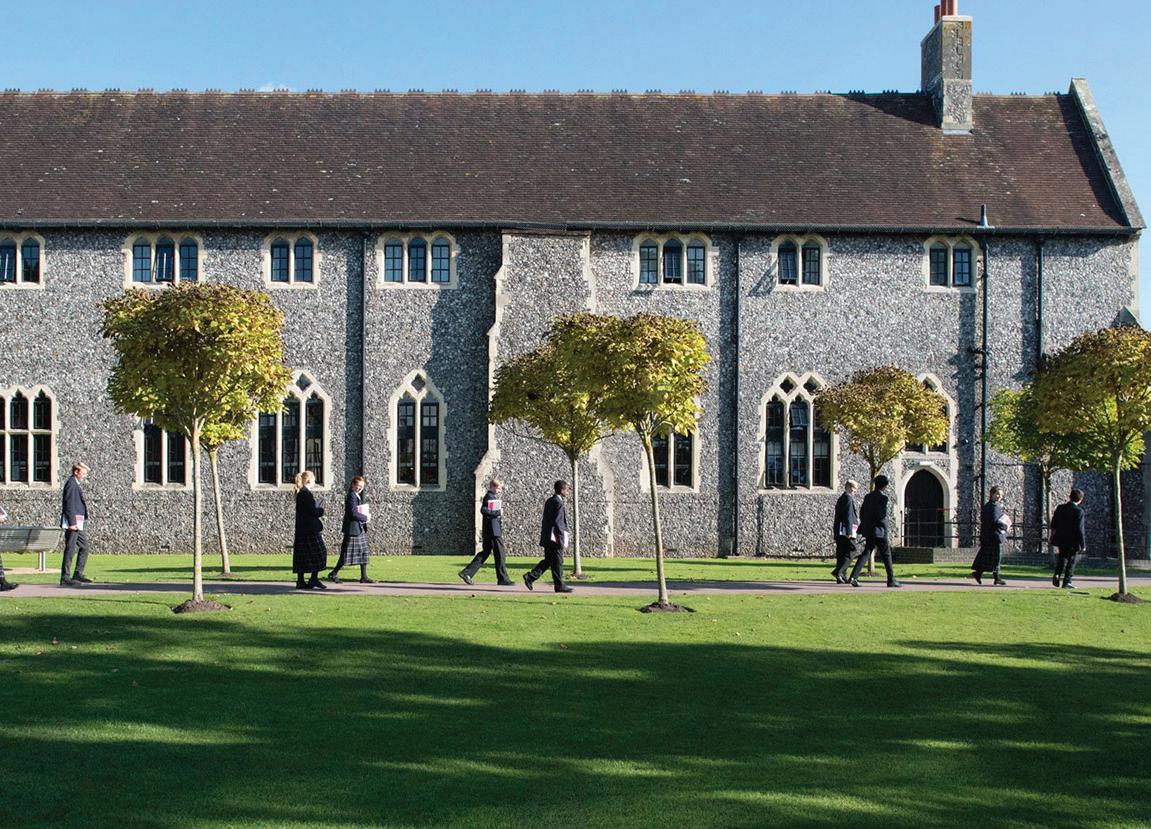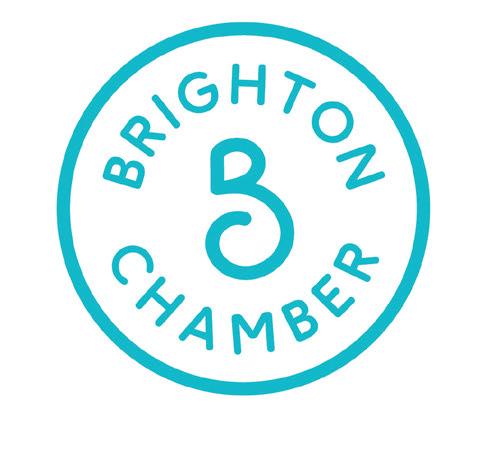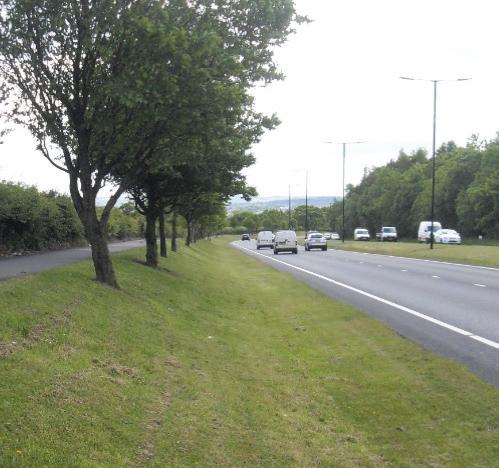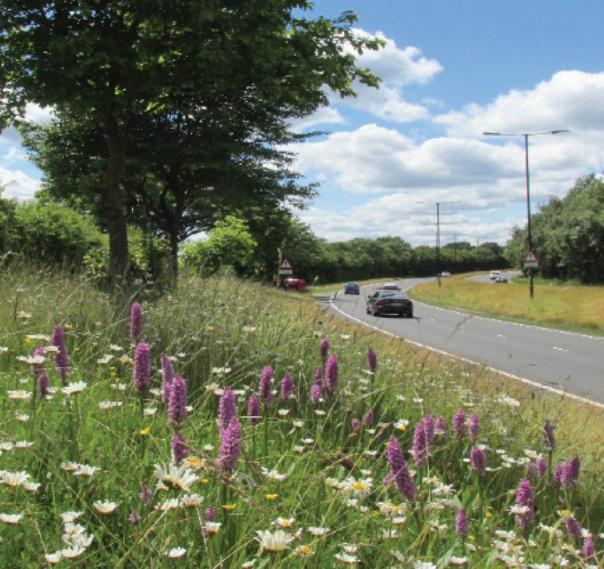
25 minute read
VIEW FROM THE TOP
Finally, schools are open and our children are back to some semblance of normality (for now!), so we thought it was a good time to sit down with the Headmaster of Hurst College, Tim Manly to find out what this new normal is like for schools and how the college fared during the pandemic and the debacle over recent exam results
With the current pandemic causing havoc around the world, with education especially hard hit, can you tell us how the school is coping and what measures are in place to keep the students safe and the school open?
Back in March, we switched to a full live online academic timetable thanks to the technology which was already in place at Hurst, the staff and their training. This proved to be successful. If we find ourselves heading back in that direction again, either with parts or indeed the whole school shutdown once more, then we can go back online. However, currently our primary aim is to ensure that as many, if not all, pupils remain at the school and that there is continuity of education for everyone. We have introduced small bubbles as well as regular hand sanitising, facemasks for Year 7 and above when indoors in the company of other nonbubble pupils along with social distancing. Our aim is to minimise the risk of infection and then transmission of the virus. I suspect that it is inevitable that members of our community will contract Covid, whether asymptomatic or not, and that this will result in some pupils having to spend time at home. We are ready for this but hope to minimise any impact. There is much debate around the subject of co-ed vs single sex education – can you let us have your opinion on this subject?
I have never held strong views on the issue of co-ed versus single sex. At a previous school, I remember gently querying why the then Headmaster, who had been a great advocate of co-education, was off to the most famous all boys school in the country. His wise response was that excellence in education comes in many shapes and forms whether single sex, co-ed, state or private, Grammar school or Academy. What was more important was that a school would enable the children within its community to thrive. As a parent of two boys and two

girls, there was never any doubt in my mind that I wanted them to be at the same school, if at all possible, in a co-educational setting and that this would be a very good preparation for life. And, my own children did seem to find the move from school to university to be pretty straightforward and much of that, I suspect, was down to their Sixth Form experience in a co-educational house which turned out to be remarkably similar to the colleges which they subsequently joined. In short, I am wary of any lobby promoting either single sex or co-ed being “better” and appropriating the data to suit.
Your recent A-Level results of 91% A*-B are very impressive – with the exception of the effort from the students themselves, what do you feel is the driving force behind these excellent results?
We have been very fortunate in the last few years to have had year-on-year increases in our results both at GCSE and A-level. During that time, we have become mildly more selective but not hugely so. We are certainly not aggressive in our approach and nor do we cull out after GCSE results. Instead, I think it is about three key factors. First, the quality of the staff and their teaching. Through the Teach Hurst programme, we recruit annually over a dozen bright, enthusiastic and committed undergraduates whom we then sponsor through a PGCE at Sussex University. They become very attuned to this place and our way of doing things. We also have a superb professional development team in place which ensures that we get the best from our staff. Second, culture.
We have at Hurst a very strong sense of who we are and what we stand for. This is not a place where outcomes are the most valued aspects of school life. Rather, we believe strongly that it is the way in which pupils approach and engage with every aspect of Hurst life which is key, almost irrespective of how brilliant (or not) a pupil might be. This is epitomised by our approach not just to the academic aspect but also the cocurricular activities. It doesn’t matter which team you’re in or whether you are the lead in a play etc. but what matters most is that you give it your best shot and you achieve your personal best. Third, and finally, there are our structures and systems. Whether that is the tutorial programmes, the Challenge Grade system (pioneered at Hurst many, many years ago and now interestingly adopted by a large number of other local schools) or our use of academic clinics and university/career coaching, the pupils do get considerable guidance, encouragement, support and inspiration (perhaps a slightly excessive word) to fully engage to the best of their ability.
How badly do you feel students were affected by the chaos over the recent predicted grades and if so, do you feel there is any long-term harm caused to their mental well-being or their future prospects ?
At the time of their release, there was undoubted turbulence. Some pupils missed offers at their chosen universities but also others felt hugely let down by a set of grades which reflected not their own ability, hard work and attitude but an
anonymous algorithm. We were badly hit. Our cohort size at Hurst is large and, as a result, there were departments here which were experiencing C and D grades for the first time in many, many years. The school was able to support the pupils and over the weekend we filed our appeals for the subjects which we felt had been particularly affected. By the following week, of course, the Government had backtracked and the result was that the pupils achieved as we felt they should have done and the vast majority, nearly 90%, were given places at their first choice of university and the remainder were able to then defer or look towards their future career and university plans with confidence. So, it was a tough experience for them but it ended in the right place and justice was seen, and felt, to have been done.
Your Sixth Form ethos of ‘work hard, do good and engage’ is admirable – how do you achieve this and instil it into your students?
This again comes down to a combination of culture, structure and people. There is a strong culture of engagement at the college. As mentioned, we do not mind whether someone is brilliant at something or not, but we care deeply that they should have a great experience and have a go to the best of their ability with the best of coaching, academic or otherwise. After all, it is through that experience that they develop in all sorts of good ways including their own self-knowledge. We also have a strong sense that life is not only about oneself but about other people and enabling them also to be successful

and happy in their lives. As for “work hard”, by the time pupils reach the Sixth Form, we hope they have not only developed very good habits but also developed a sense that working hard is key to one’s own sense of self respect as well as achievement. If you are going to do something, then you should really give it your best shot.
Sixth Form is such an important step – not only from an academic point of view but a major step in ‘growing up’ for young adults, and your phrase ‘trainee undergraduates’ is notable as that is exactly what they are. How do you drive this ethos right the way through the two years?
A key part of a Hurst education is the recognition that school is not an end in itself but rather the beginning and a springboard to the next stage of our children’s lives. As many of us as adults will remember, Sixth Form is a great period of self-definition. Whilst the younger years are about trying to develop good habits, the Sixth Form is a pupil’s chance to really grow their own

self-knowledge, a sense of what is right for each of them as well as an awareness of the world around and beyond them. It is a gradual process. Nobody steps into the Sixth Form as a fully formed Sixth Former but rather there is a gradual development. They are treated as adults and join our Upper Sixth co-educational house where, as a year group together, they get a flavour of that life which they will experience at university and beyond. Most importantly, during this time, we see our pupils becoming much more accepting of others and, indeed, of themselves and this sense of self, along with greater independence, intrinsic motivation (their “why?”) and real interest in what might be possible means that they move towards a position of readiness for undergraduate life where these things will become critical and when they will not have the bicycle stabilisers, as it were, of school.
We hear about girls continuing to excel in STEM subjects – is this your experience? There is no doubt that one of the greatest and best changes in the last 30 years of secondary education has been the rise of girls studying STEM subjects. At Hurst, at least half of the female Sixth Formers go on to study a STEM subject at university, examples in the last three years include: Computer Science at Durham, Physics at Imperial, Medicine at Nottingham, Biology at Oxford, Mechanical Engineering at Sheffield, Mathematics at Cambridge, Veterinary Medicine at Edinburgh and Chemistry at UCL. If I may speak as a parent, all four of my children did Maths and Further Maths and one daughter studied Physics at university. I do not, for a moment, say that there is complete equality in all subjects between the genders. But there is certainly an equality of opportunity and a perception whatever their gender, they can pick any subject and think “why not?”
www.hppc.co.uk
LAST FEW DAYS TO BOOK


Brighton Base Camp is a virtual event packed with inspiring speakers, great networking, and fascinating workshops that will change the way you think. Although you’ll be joining remotely, you’ll be part of something exciting, intriguing, and welcoming.
THREE REASONS TO BE THERE
Run by Brighton Chamber, there are three reasons to be there on the day says Laura Barban, the Chamber’s Events Manager. 1/ 120+ brilliant people attending that you could meet and network with 2/ Three inspiring speakers not to miss. 3/ Five brilliant workshops to choose from.
ROLL THE DRUMS
… or rather, dim the lights – we are rather pleased to be able to announce the third keynote speaker at next month’s Brighton Base Camp: Bananas.
Lyn Goleby is someone who has had a pretty unusual career change. A former solicitor specialising in media law, she cofounded Picturehouse Cinemas in 1989. After the company was sold to Cineworld, Lynn stayed to build three more cinemas on the Picturehouse model while working on the development of six more. She’s also behind the flagship Picturehouse Central, once an underperforming multiplex site in Piccadilly and now the sixth highest grossing cinema in London. Today, Lyn is involved with a number of businesses including cinemas and a contemporary social bingo venue. She is Executive Chairman of Trafalgar Releasing, a company that distributes live events and arts programming to cinemas worldwide.
Lyn will talk about building a business by trying something different – and what it’s like when that “something different” is a widely-copied massive success. She’ll also discuss how she made the difficult decision to move on. And she’ll also talk about the present – having a business based on social gatherings during these troubled times – and what comes next.
FIVE WORKSHOPS – YOU CHOOSE
The secret to delivering your next game changing product or service led by Toby Kress, Programme Director at Plus X.
45 fast workshop where you’ll learn the agile approaches, entrepreneurial mindset and practical tips to transform your organisation into an innovator.
HOW TO JOIN THE EVENT Book your place here https://brighton-base-campbananas.eventbrite.co.uk
Ticket sales will close on Friday October 9th at midday PLATINUM READERS CAN CLAIM £5 OFF USING THE DISCOUNT CODE FRIENDS5
n Release your inner cartoonist! Led by
Harry Venning, cartoonist. n A workshop that will free you of thoughts such as ‘I can’t draw’ and ‘art is not for me!’ n Practical resilience: mindsets and techniques that really work, led by
Toby Buckle, Hazelbranch. n A practical workshop which will help you change the way you approach challenging situations. n The power of 5 – exercises for your body and mind, led by Camille Pierson,
The Float Spa. Just 5 minutes can make the world of difference, and during this session, you’ll find out how. n Presenting Yourself Positively, led by
Jude Bolton, Speaking Works. n Learn to banish those pesky nerves and communicate with confidence and clarity.
A huge thank you to:
Media partners Platinum Business Magazine and Chimera Communications.
Sponsors Cardens Accountants, Shoreham Port, Cognitive Law, Let’s Do Business Group, Ingenio Technologies.
Branding by Visual Function and Sandra Staufer, copy by The Sentence Works and Digital Firefly.

DON’T MANAGE YOUR BIRD PROBLEMS ON A WING AND A PRAYER
Pest birds can be a cause of havoc around, on and inside all types of buildings and if left to nest and breed they are a serious health hazard
Pigeons often gain access to lofts and empty buildings. Once they start to breed, the build-up of guano is considerable. Pigeon guano carries all sorts of diseases including E.coli, Salmonella, Psittacosis, Ornithosis etc. There may also be Bird mites and fleas present in nesting material. Lofts should be cleaned out and infested areas fully treated with biocide. All dead carcasses and mess should be removed from site under Waste Disposal Regulations 1994.
The use of natural pest control using predator birds is becoming increasingly popular at both industrial and residential sites. Before any action is taken a survey by a professional specialist should take place to identify the species of bird, the problems they are causing and recommend the best methods to deal with them.
HERE ARE SOME OF THE OTHER METHODS
NETTING
All types of buildings can be proofed, from private homes, to churches, industrial premises, offices and blocks of flats. Other areas include water treatment plants, farms, marinas and vineyards.
Different sized mesh is used, depending on the type of bird. Nets are UV treated, can be flameproof and are guaranteed for 10 years. All straining wires and fixings are stainless steel. Nets can be installed almost anywhere, providing a safe means of access can be worked out. It is vital that netting is properly and professionally maintained as part of a pest prevention contract.

BIRD FREE GEL
This innovative product reflects ultraviolet light. It appears to birds as flames and keeps pest birds off structures without harming them. Rather than acting as a barrier like netting or spikes, the gel alters birds’ behaviour. Birds will completely desert a habitat, even one they have been using for years, once Bird Free has been applied.
BIRD SPIKES
Only stainless-steel wire anti perch spikes should be used and fixed to an ultra-violet treated base. Over time less expensive plastic spikes deteriorate with UV rays, become brittle and break. Spikes are fixed down with suitable adhesive. Problem areas include, window ledges, fire escapes, waste pipes, gutters, roof ridges, chimney stacks and pots.

POST AND WIRE SYSTEMS
This system is mainly used on ornate buildings where it is less obtrusive. It can be difficult to install and take some time. Depending on the base strata, stainless steel rods are either drilled into position or stuck down at suitable intervals. Sprung wires are run between the rods. It causes no harm to birds and has even been suggested for use on some sites by the Royal Society for the Protection of Birds.
BIOACOUSTICS
A system of speakers, set up to play at random the natural species distress calls, creates an environment appearing ‘hostile’ to the birds. Bioacoustics are used anywhere where birds present a hazard to health and safety, or just a plain nuisance.
Go to www.cleankill.co.uk for more information and email info@cleankill.co.uk for a free pest control survey or cost comparison.
GIVING GREEN ROADS THE GREEN LIGHT
Climate science tells us, in no uncertain terms, that the world’s climate has changed – and continues to change – at an unprecedented rate. Now, as we stand at a crossroads, we’re faced with a choice: ignore repeated warnings to reduce our carbon emissions or take action before it’s too late.
The good news is that many organisations, large and small, have recognised their responsibility to contribute towards creating sustainable communities and ensure that they leave a sustainable legacy for generations to come.
In Surrey, several companies are committing to this path. Amey, a highways and infrastructure specialist that collects the waste of four district councils in the county, is one of them.
So how, exactly, is Amey spearheading change, not just in Surrey but nationwide, and how is it laying the foundations to ensure that sustainability, in the widest possible sense, remains at its core? To answer this, we need to explore the wider picture.
WORKING TOWARDS NET ZERO
The UK has committed to move towards a net zero emissions economy, whereby any emissions generated are balanced by the equivalent amount being absorbed from the atmosphere, in order to halt the negative impact of climate change. As the UK government works towards achieving net zero, Samantha Schofield, Environmental Business Partner for Transport Infrastructure at Amey, explains how large service providers are raising the bar in order to tackle climate change.
To meet the 1.5 degree Celsius global warming target reduction, as set out in the Paris Agreement, many developed nations including the UK are aiming to meet net zero by 2050. To support this, Amey is working closely with its clients to help them achieve their sustainabilityled ambitions, all of which require bespoke solutions.
Given the sectors in which Amey operates this is no small feat. Yet, through collaborating with our supply chain network and local councils UKwide, we’re on course to achieve this target and improve the lives of those living within the communities in which we operate. And this isn’t purely long-term thinking; much of the work is happening in and around communities now. Take Surrey, for example, where Amey collects the waste of Mole Valley, Woking, Elmbridge and Surrey Heath residents. This year alone the waste collection team has reduced carbon emissions attributable to vehicle idling by 42% across its entire fleet. Using telemetry data, we can establish idling levels by each individual lorry and driver from the moment the vehicles leave the Elmbridge depot on Mill Road, Esher. From this information we can then seek to change behaviour.
Yet, reducing vehicle idling is only a

small part of a wider series of initiatives that Amey is currently rolling out as part of its green transport commitment; a commitment which, through working with the Carbon Trust, decarbonising our entire fl eet and transitioning to electric and alternatively fuelled vehicles, may soon see vehicle idling become a thing of the past.
GREENER, LEANER FLEETS IN PARTNERSHIP WITH LOCAL COUNCILS
The effi cacy of governments around the world, which are often voted in for four and fi ve-year terms, is often a source of debate. After all, how can a government realise its true vision, particularly one set to span three decades, as is the case with the journey to net zero, if it only has a relatively short timeframe in which to implement it?
This is where Amey differs. Many of our contracts with local councils run for over two decades, a period of time in which we can implement real change and where long-term visions can be realised. Our 25-year Streets Ahead partnership with Sheffi eld City Council and our approach to adopting a low carbon fl eet in the city illustrates this.
Using a PAS 2050 carbon forecast model - the British standard widely used by businesses to calculate the carbon footprint of their goods and services – we established that a key source of carbon emissions was linked to the project’s supply chain, which included Amey’s vehicle fl eet. Working in collaboration with the council, we began trialling hydrogen and electric vehicles across our light commercial fl eet, the result of which has already saved 1,791 litres of diesel and reduced CO2 emissions by over three tonnes. Over the vehicles’ lease period, we expect this fi gure to increase to 5,625 litres and 14.6 tonnes of CO2 emissions.
Carbon reduction of this scale does not end at Amey’s electric and low carbon vehicles; our impact is also being felt across many areas of the business. Amey’s commitment to biodiversity has seen us work closely with Highways England and we’ve also established a number of UK-wide tree planting initiatives. As part of The Living Highways Project, and through our work with Sheffi eld City Council, we’re looking to establish if biodiversity and ecosystem services can be enhanced on road verge sites, all whilst reducing maintenance costs.
A LIGHT BULB MOMENT
Another example where our positive impact is being felt is the more nuanced area of highways maintenance: street lighting.
To date we have installed over 200,000 LEDs in streetlights within 14 local authorities, which is not only cutting councils’ carbon, but also their cost. In August alone, Amey won the contract to upgrade City of Bradford Metropolitan District Council’s 56,500 street lighting assets, which will see 48,300 existing streetlights replaced with LEDs – a move that is expected to reduce energy consumption and carbon emissions by 65%.
As with any major shift, particularly one that requires the adoption of new technology, there is a cost. Therefore, making sustainability as accessible as possible on the journey towards net zero is essential – particularly for local councils who are already expected to achieve more with less.
THE ROAD TOWARDS A GREENER ECONOMY
Earlier this year, Amey, in collaboration with the Association of Directors of Environment, Economy, Planning and Transport (ADEPT), launched a Green Finance Toolkit to help local authorities with green fi nance.
The move supports the government’s Green Finance Strategy, which seeks to ensure that government and the public sector work together to fund green projects and align private sector investment with clean, sustainable and resilient growth.
Through our own series of initiatives, Amey is very much on the road to net zero. In fact, every solution designed by Amey will include a low carbon option by 2023. However, in order to make it viable for all of our stakeholders, from local councils through to our suppliers, we have to make low carbon solutions accessible and practical.
Given our success to date, both at a Surrey level and nationwide, and through our on-going commitment to addressing the growing climate emergency and a range of measures designed to improve bio-diversity, we are confi dent that we will not only achieve net zero in advance of the government’s target, but also play a signifi cant role in shaping sustainable communities as part of our journey.

For more information on Amey’s journey towards net zero visit www.amey.co.uk

OVERCOMING THE TOUGHEST
LEADERSHIP CHALLENGE


By Dan Morgan, Managing Partner, Haines Watts Esher
Business owners have arguably been going through one of the toughest times of their leadership career. With the pandemic creating challenges many wouldn’t have imagined facing, leaders have had to shift their way of working in the face of immense pressures from both their personal and professional lives. However, the dramatic change in working practices has also revealed key areas for growth in leadership styles which should be incorporated into your long term plans for the business’s recovery and beyond.
No experience or training in the world could have prepared business leaders for this crisis and yet you are the one that needs to provide direction, to be the clear voice of reason and have the answers that no one else is able to provide. Business owners have needed to be available and ‘on’ at virtually all times, this can lead to a silo effect with you making all decisions alone, which isn’t sustainable for you or your business.
Remember that you may not have all the answers all the time. I have found, and I’m sure most business owners would agree, that our people have been the biggest asset throughout this time. Feedback from my team on the ground has provided a detailed and in-depth view of the state of the business which in turn has allowed me to make quick and informed decisions. We have worked hard to ensure we have a team who have a vast array of experience and so my team members will always look at things at a different angle to me. This collaboration within my team helps ease the pressure and ensures we are always coming up with creative ways to tackle problems. The way I communicate with my wider team has changed hugely over the last few months. Transparent and consistent updates to our people has allowed the team to feel they full understand the direction we’re taking but this also allows them to provide feedback on it. Don’t be afraid to receive feedback from your teams, it is a great way of gaining objective and quality information on not only how they are feeling but also clients and anyone that you may not interact with on a daily basis. I have found having more regular and open conversations with my team has allowed them to feel able to challenge me and gain their perspectives.
Without doubt, the way you lead will constantly evolve with countless learning opportunities along the way. Surround yourself with the right team and advisors that offer you perspectives you may not have considered. This will allow you to provide yourself opportunities to look at the bigger picture and pull yourself out of the everyday running ensuring you are always moving yourself and your business forwards.

For more information: https://www.hwca.com/ accountants-esher/ T: 020 8549 5137 E: esher@hwca.com

1PLAN AND PRIORITISE The fi rst thing you should think about is planning your strategy, and prioritising resources so they go where they’re most effective. This cuts down on any time and resources you’re wasting, helping to also cut costs which will help you through any downturn.
3LOOK FOR FREE AND CHEAP BUSINESS GROWTH IDEAS If you come across any free or cheap ideas to promote yourself, don’t ignore them – it’s free advertising and worth a go, even if it doesn’t work out the fi rst time. Even if you take on the paid services of a consultant, they’ll be able to recommend free business growth strategies to keep costs down.

5ENLIST PROFESSIONAL HELP It may seem counterintuitive when funds are tight, but enlisting the help of professionals can really help to turn your business around. They’ll have years of experience in helping businesses grow. The initial investment you make in hiring them should soon pay off with the new revenue they can help you to generate.
6BUSINESS GROWTH IDEAS TO TRY
EVEN DURING TIMES OF ECONOMIC UNCERTAINTY
Graham Garman has over 25 years of business management experience, which he brings to his role at Chrysalis Partners South, the business growth experts serving Surrey and beyond. He knows that a combination of factors mean that times are tough for business owners. How can you encourage growth, even during periods of economic uncertainty? Graham has put together 6 top business growth ideas that may just help!
Chrysalis Partners South have over 50 methods to help businesses grow! Investing in business growth is a proven way to reap many rewards, so get in touch with them today to discuss how economic uncertainty doesn’t have to mean the end of business growth.
2DON’T BE AFRAID TO REACH OUT Times are totally unprecedented. Everyone is going through it together, so don’t be afraid to reach out and support each other. Knowing that you’re not alone can do wonders for morale. Plus, by keeping your network strong you may be introduced to connections that can help you!
4DON’T IGNORE SOCIAL MEDIA Speaking of free business growth ideas, NEVER ignore social media. It’s probably the number one way to reach customers in this day and age. No matter what sort of operation you have, there are people on social media who would be interested in it. You just have to fi nd them. Research is key here to fi nd what works best.
6THINK ABOUT PIVOTING If your business is really struggling, have you thought about pivoting? Pause and think about if there are any new directions you could take that are more suited to consumers and their current spending habits. If you don’t want to pivot completely, could you open up a new arm of your business that offers something different?








